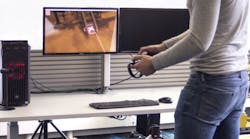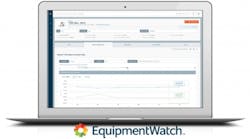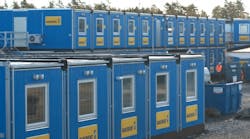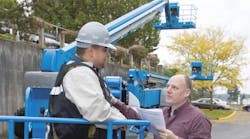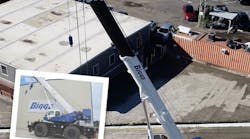Whatever you need to do at a rental center, software has you covered.
When Brad Kniep of Peoria Rentals in Peoria, Ill., opens the doors to his rental store each morning, the first thing he does is check Day-at-a-Glance, a dashboard he, like other Point of Rental users, has customized to show him the data he finds most useful. He can see an overview of the day’s orders, deliveries, pickups and returns, or specific reports, all on one screen. He will also be notified of any overbookings, missed deliveries, overdue items, past due accounts, or any other issues that may need immediate attention.
Kniep also might check out his ROI reports and review his corporate clients’ revenue variance reports, which allow him to see which clients are coming around as often as they always have – and which may need outreach. He can look through dozens of future trend reports, which help him chart the course for the future of his business.
The owner or manager is not the only one relying on this software. When a rental center’s full staff arrives, the software becomes the hub that connects every part of a rental business. Counter staff, yard workers, service technicians, dispatchers, truck drivers, accounting staff and other office personnel, sales people -- both outside sales staff and inside counter staff – and virtually all other employees of a rental company are likely utilizing the same system and are connected with one another. And, increasingly, customers of the rental company can log in and gain access to a wide range of information that will help them rent equipment, call equipment off rent, keep track of the equipment they have on rent, and more.
Counter staff using Point of Rental open their dashboards to verify all outgoing orders are confirmed, in the ready line, and scheduled on a delivery route, says Wayne Harris, CEO of Point of Rental Software. “They review any orders that came in after yesterday’s close through the website integration and can confirm them, automatically generating a contract. Once the contract is generated, yard staff can see it in real time on any smart device through Contract Fulfillment,” he says.
When yard workers arrive they verify that their confirmed orders from the previous day are in the ready line. They open Contract Fulfillment on their tablet to see new orders that are ready to be pulled as well as all items being returned. When items are returned, they enter fuel and meter readings, and take notes. The notes are automatically reflected on the contract, allowing counter staff to view it in real time, reducing customer wait times. After the equipment is marked returned, it automatically generates an inspection request.
Mechanics open the Inspection App from any smart device, where they see their assigned jobs, or the entire team’s assigned jobs, depending on the access the manager gave them. When the mechanic starts on a job, he uses the preloaded checklist specific to each piece of equipment and marks each category as pass or fail, adds notes, and loads condition photos. If a critical checklist item fails inspection, an internal repair or maintenance order is automatically generated and the item is taken out of inventory until the repair is complete. The repair order will also reflect any notes or condition photos taken on the Inspection App so that the service tech can see what’s wrong before they even have their hands on the item.
Users of other systems have similar capabilities.
“Yard staff and service techs rely on rental software to determine what equipment needs to be made rent-ready,” says Matt Hopp, general manager, InTempo Software. “They also know what rentals are up next so they service the right machines at the right time. In addition, yard staff uses the software to make sure they’re able to maximize equipment utilization. A number of InTempo customers keep a dashboard on a large TV monitor in the shop so they can determine what needs to be done next, and update the information as they work. Service techs often update work orders directly in the system, entering in parts they use on the work order, billing them out, and then removing them from inventory.”
“Yard staff can be assigning actual rentals to a contract, via barcode if they choose,” adds Kara Lawrence, co-owner, Alert Management Systems. “They can do check-ins, complete automated count sheets, product inspections where photos can be taken and incorporated into Alert EasyPro and the billing cycle for substantial documentation of any damages or misuse.”
“Yard staff will use our mobile app to create/edit repair tickets for the equipment as well as create dispatch tickets for their truck drivers to claim. Our mobile app allows the service tech to create a mobile repair ticket,” adds Jason Rosen, account/project manager, Corporate Services. “They have the ability to create a work order for the asset being repaired, record what services were performed, as well as record any parts that were consumed during the repair. If it’s a service they are performing, they can create a mobile field ticket with our mobile app that automatically gets processed into a rental contract.”
Hit the road, Jack
Dispatchers and truck drivers are often the first to arrive at a rental company.
With Point of Rental, the dispatcher starts the day looking at Dispatch Center, reviewing the confirmed contracts already routed from the previous day, which truck each is on, who the assigned drivers are, and any contract details, says Harris. “They’ll also see any add-on orders that need to be prioritized for the day and check routes to assign any nearby pickups,” he says. “With GPS integration, they can see each driver’s location on the map and time-stamped deliveries and pickups. When planning routes, they’ll be able to take contract notes, diagrams, and layouts into account, ensuring accuracy.”
When drivers enter their trucks, says Harris, they connect to the software, where they can clock in and see their routes with turn-by-turn directions. When they arrive at each stop, they can take condition photos that are geo-timestamped for verification, make notes, and get the customer’s signature – all straight from the app. The information is then reflected back into the contract in real time. If the customer has a phone number or email address and has requested updates, the app will automatically send an “on-the-way” notification once the driver marks the previous stop as completed.
“Dispatching staff will use the map to view deliveries, pickup for the day and field technicians’ routes,” adds Patrice Boivin of Orion Software. “They simply need to drag and drop the resources to the transactions to notify the drivers and technicians in the field in their mobile app. The drivers or field technicians will follow their schedule and notifications to open a work order, follow instructions, complete inspections, take pictures and fill-up their time sheets.”
Hopp says InTempo Software is up-to-the-minute when it comes to routing drivers. “If you’re a truck driver, your goal is to take the ‘best’ route,” he says. “However, the best route isn’t necessarily the shortest route. InTempo’s integration with industry-leading dispatch software means that drivers can ensure variables such as truck routes and traffic are taken into account.”
“Upon completing a delivery, the driver will capture a signature to confirm the customer has received the equipment,” says Marc Tedeschi, U.S. general manager, inspHire. “Once the driver hits complete, this will automatically feed back to the rental desk, informing them that this job has been completed.”
Sales epicenter
Sales is a big part of a rental company’s operations, whether it’s inside sales by counter personnel, or outside sales staff visiting jobsites and using tablets or mobile phones to connect to the company’s software system. Sales people usually plug into software to start the rental day.
“Sales staff looks at customer revenue variance reports to see which customers had previously been big renters and haven’t rented as much recently, top customers reports, and revenue by zip code reports, pinpointing where their time is best spent,” says Harris. “Whether they’re at the office or on the road connecting with customers, they can view each customer’s information, see open invoices and history, take notes, make call logs and even integrate all that information with Salesforce. With an internet connection and their laptop, sales staff can check item availability, make quotes or even generate orders depending on the level of access each user has been granted by their manager.”
“If they need to manage a sales issue, they use the graphs and calendar integrated in the transaction screen to resolve a conflict by transferring equipment, opening a P.O., sub-rent or open a work order for a technician in the shop or in the field,” says Boivin. “Automatically, the system will start alerting the other branch for the transfer or notifying the technician on his mobile device that a maintenance task was added to his schedule. Also users can assign tasks to other users to collaborate on an opportunity.”
Corporate Services also offers real time inventory levels for sales as well as rental. “Equipment or parts that are sold are relieved from inventory the moment they are sold,” says Rosen. “Rental staff can see at any given time, accurately, where their inventory levels are at. Along with our re-order level functionality and P.O. module, ordering new parts with minimal effort is at their fingertips.”
InTempo’s software, says Hopp, offers intelligent analysis for sales people. “There are two major areas of focus for sales,” he notes. “The first is centered on equipment: What do you have that’s ready to rent, and what rates should you set? If you only have one more unit of an in-demand piece of equipment, you won’t want to offer any deals. But if you have equipment sitting unused, you may want to offer a discount. The second area of focus is on the customer: Is the customer in good standing based on credit history and A/R aging? Are you being proactive about marketing to those customers you haven’t rented to recently? And when it comes to new clients, if you are offering a discount — is the ‘acquisition cost’ still ROI-positive? In other words, are you (literally) getting what you bargained for? With InTempo’s advanced reporting features and rate structure/billing options, sales reps can make the right decisions for each individual customer.”
Baseplan CRM also manages all sales activity under one system that updates in real-time. “Baseplan’s CRM also connects to our Rental Module, so rather than using Word or Excel templates by entering in all information manually, sales teams can immediately create rental and sales quotes,” says Mark Simonsen, business development manager, Asia Pacific for Baseplan. “Often times offering discounts without approvals or waiting for a response, rental and sales quotes have discount approval levels built in, to save time and money. In addition, new equipment gets managed in within our Sales Quotes module to cover not just standard builds, but also extras, purchase orders, and even asset capital preparation.”
Software can help inside sales staff as well. “When an item is scanned using inspHire, a pop-up box will appear detailing all the recommended accessories to be sold alongside the item,” says inspHire’s Tedeschi. “This identifies fantastic cross-selling opportunities for sales staff, as well as giving the customer better service as they may not have known that they need further equipment to complete the job.”
Integrated system
The work of the accounting staff is far easier with today’s more sophisticated software systems. “With auto-invoicing, the system will automatically email a customer their invoice when the contract is closed,” says Point of Rental’s Harris. “Statements can be mass-generated and emailed daily, weekly, or monthly – whichever the accounting staff prefers.”
“Office staffers are able to manage all aspects of the business from a single integrated system,” says Baseplan’s Simonsen. “Depending on the scope of work, typical office staffers will be able to manage rentals, CRM, accounts payable and receivable, payroll, service management for scheduling and job allocation, parts management for reordering and forecasting, project costing, purchasing, asset management and reporting on a weekly if not daily basis.”
“Our sophisticated all new Document Center is a graphical dashboard that allows users to handle sending of bids, reservations, closed tickets, and statements from one central location with the touch of a button,” says Alert’s Lawrence. “The sooner a closed ticket is in your customer’s hands, the sooner it’s paid!”
Customer control
Speaking of customers’ hands, increasingly customers are managing their own accounts, on any device they choose, and a customer interface is now expected from a software system. “Instead of visiting or calling the rental store, customers can use a mobile application to order new equipment and manage their current contracts,” says Orion’s Boivin. “Users will see the new transactions coming in the dashboard and handle them almost entirely as a normal order. The delivery will be scheduled and customer informed. Off-rent requests will come as alerts into Sirius e and added to the pick-up route plan.”
“Our software offers multiple ways to manage our clients’ rentals,” says Corporate Services’ Rosen. “In real-time, they can see what’s available, what’s out, create rental contacts, manage repairs, create invoices, create purchase orders, as well as manage their deliveries with our mobile app.”
Often the rental process begins with the customer online and connectivity informs the entire process. “First, a customer will want to rent something and peruse our client’s website and start a ticket,” says Alert’s Lawrence. “From there, the ticket will either automatically become a reservation with our E-Commerce solution, or a salesperson will bring up the ticket and contact the customer to complete the bid. The final bid can be sent to the potential customer to sign electronically via Sign & Rent, and the appropriate deposit securely collected via credit card. Inventory will be committed in the system, or sub-rented. When delivery day is near, the dispatcher will use our graphical Dispatcher Dashboard to load trucks and schedule drivers. GPS tracking will enable dispatchers to see where drivers are, and equipment with GPS units can let the yard know where equipment is and how it’s being used. If the rental is long term, the back office staff can continue billing on scheduled intervals, including collecting payments.
“At the end of the rental, Alert EasyPro calculates any balance due based on utilization and the dispatcher can either schedule a pickup or the customer can return the equipment. Upon check-in, the Alert user can photograph the condition of the equipment and this information will be retained with the ticket indefinitely. A final closed ticket is sent to the customer, and the accounting office can visually see aging invoices in the Operator Dashboard and effortlessly send documents such as statements or closed tickets in the Document Center. Customers can log on to the website to pay their balances, rounding out an easy, yet sophisticated, process from start to finish.”
Inventory management
In the past, a branch manager would most likely go out to the yard and count how many skid-steer loaders were on the line and that’s how he’d know how many he has available. Many still do that, but presumably a company’s software will track this information, and for multiple locations. Gut feel would probably be the primary source of analysis regarding how many more units the company needed to buy. Gut feel still plays a role because predicting upcoming trends is an inaccurate science at best. Still, real-time information is critically important.
“Inventory managers are looking at their ROI and utilization reports, item overbooking reports, revenue vs. cost of repair reports, and future trend reports to decide which items they should be buying more of and which items need to be sold,” says Point of Rental’s Harris.
And keeping up to date on equipment availability no longer usually requires calling around to multiple branches to see what’s available at their yards.
“The biggest issue we solve is maintaining an inventory company wide,” says Corporate Services’ Rosen. “Everyone accesses the same information real-time. No more excel spreadsheets that need to be manually updated after an item is sold or rented.”
A growing trend in the rental industry is for rental companies to manage the assets of their customers.
“Some of our customers were awarded large contracts to manage their customer’s assets in combination with their own rental equipment,” says Orion’s Boivin. “Their customers wanted a better control over their assets and be more efficient at renting equipment. We provided their customers with a Web portal in a browser and mobile devices. It was so simple to use that they adapted the application quickly as their standard to manage both types of equipment. This is a clear example of how the rental software can make a significant difference in a growth strategy.”
Reports on demand
Reports covering a range of topics are available on demand with most software systems.
“There are a number of reports that management should keep a pulse on at all times: utilization, revenue, equipment status, A/R aging, and daily activity (pending contracts, pickups, and deliveries),” says InTempo’s Hopp. “InTempo’s mobile app makes it possible to access this information anywhere, at any time, through easily digestible dashboards. Other common reports include equipment lifecycle, employee performance, purchasing/receiving, income statement, balance sheet, and cash flow. Each business will also inevitably have reports unique to its organization; the key is whether your rental software is flexible enough to give you the information you need to make critical decisions and find profit.
“Different reports are pertinent to different people at different times of the day. One example is an overdue contract report, which is critical with cash customers to ensure you have collected the appropriate deposit amounts for their rentals. Another is a report that shows customers who are over their credit limit with accounts on hold to monitor for upcoming reservations. That’s why the importance of being able to view key reports from the office, your home, or in the field via a mobile app, goes without saying.”
“There are hundreds of reports built into the system to give managers a real-time look at their data and help make intelligent business decisions,” says Point of Rental’s Harris. “KPIs may change over time, so a well-designed system gathers and stores all data points in real time, providing accurate reports whether it’s a new measurement you’d like to see or the first report a manager looks at every day.”
Rosen of Corporate Services says utilization reports are requested most often. “[Rental companies] more and more want to know the ROI when it comes to their assets,” he says. “Items on rent is popular too. Our clients always want to know what’s currently on rent and to what customer.”
Rosen considers reports that show what assets are making the most and least amount of money are most important, as are reports that show upcoming preventive maintenance to make sure equipment is maintained and up to date.
Baseplan’s Simonsen says “profit and loss by company, branch, division and equipment, average rental rates for equipment by branch, and equipment terminated but not returned,” are important reports. “Sales teams can run a report with service jobs estimates vs. actuals, and a quote conversion rate by sales rep.”
inspHire’s Tedeschi says rental companies appreciate its Asset Analysis report that shows how much equipment is costing in breakdowns and repairs compared to the revenue it has made and how much it is worth based on the depreciation.
Orion Software offers “simple metrics to measure operation activities such as Utilization Value and profitability and more sophisticated metrics such as ROI percentage and Days Utilization. We provide the metrics in the mobile app for the top management to keep an eye on their performance whenever they have time.”
However, Boivin talks about the benefits of providing alerts to proactively advise specific users of upcoming issues.
“During a typical day, users don’t need to worry about a potential availability problem or a maintenance item due or a field technician tasks,” he says. “The application will provide an alert or a notification on the mobile devices. Users simply manage the standard rental process and exceptions or potential errors are managed through alerts, notifications or automated reports.”
While rental company management must guard against information overload and remain focused on the most essential information they need, almost any type of information and analysis is available at their fingertips. And software companies keep developing quicker and better ways of doing things.



